This Is Probably The Most Useful Scale In Jazz Improvisation
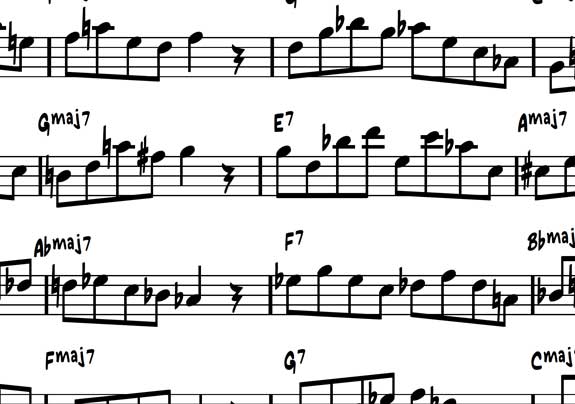 Scales are the “raw material” of melody, whether improvised or composed. It’s not likely that you’ll study jazz improvisation to any serious degree without spending a lot of time learning, exploring and creating melodies with scalar material (as well as understanding how these scales relate to harmony).
Scales are the “raw material” of melody, whether improvised or composed. It’s not likely that you’ll study jazz improvisation to any serious degree without spending a lot of time learning, exploring and creating melodies with scalar material (as well as understanding how these scales relate to harmony).
In modern jazz improvisation, many different scale colors are used: diminished, major (including Lydian and other modes), minor, blues scales, dominant 7th scales, pentatonic and hexatonic scales…If you spend time with them you can find lots of musical possibilities.
I myself have spent lots of time over the years working with scales as I study improvisation. In my explorations I’ve found the melodic minor scale (in ascending form, i.e., a major scale with a flatted 3rd) to be the one of the most useful. There are three reasons why:
First, the scale has a naturally beautiful contour, which invites compelling melodies. Take a look below at a C melodic minor scale:

Because it contains two tritones (Eb-A; F-B), it easily and naturally moves in and out of tension, folding and unfolding into resolution. If you were to just improvise using the notes of the scale, you could find lots of cogent sounding melodic possibilities.
The second reason I find this scale so useful is that it offers a different perspective in understanding natural, as well as altered, harmony over dominant 7th chords. Look at the example below:

This is how the melodic minor is typically applied over dominant 7th chords in modern jazz. I’m using a C melodic minor over a B7 chord (the scale one half-step above the root of the dominant 7th chord, which is commonly referred to as the “jazz” minor scale). If you analyze it you’ll see there is a good amount of harmonic tension. In fact, it contains all 6 “tension” tones over the dominant chord that seek resolution, specifically: F (functioning as the raised 11th), A (7th), C (lowered 9th), Eb (functioning as the 3rd), G (lowered 13th), and D (functioning as the raised 9th).
But now take a look at the other examples below, using the exact same melodic pattern formed from the C melodic minor as it is applied to other dominant 7th chords:
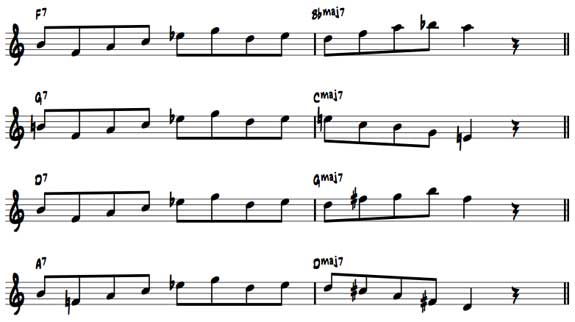
You can analyze each of these V-I patterns to see that the harmonic functions of each note of the minor scale changes in relationship to the dominant chord. Play through these patterns and you’ll hear 5 different colors of tension to resolution, some with lots of altered harmony.
When applying the melodic minor scales to dominant 7th chords, I tend to think of them as if they were in the “second octave above” the diatonic notes of the dominant chord scale. I’ll use the F7 chord as an example:

In the first two measures are the notes that are natural to the F7 chord (the Bb major scale). In the second two measures (going into the “second octave”) I replace this scale with the C melodic minor. In this particular example, the only real change is that the ‘B’ is made natural in the second octave (functioning as the raised 11th relative to the F7). The rest of the notes are in common with the Bb major scale. And of course you can do the same thing with the other keys I’ve used above as examples (I’ll demonstrate this more precisely below). In doing so, you’ll find varying degrees of harmonic alteration relative to each dominant chord, as well as tones common to the diatonic scale of the dominant chord.
This was the way the great tenor saxophonist and improvising genius, Warne Marsh, approached altered harmonic tensions (he taught his students to think and hear this way, as well). It lends a melodic/scalar context to altered notes and invites a more linear conception to improvisation.
For each dominant 7th chord there are 5 different melodic minor scales that can function in this “second octave” manner. These 5 scales function as so because they contain various altered and unaltered notes that tend to move toward release to the tonic, yet don’t have a raised 7th, which would compromise the essential quality of the dominant 7th (unless it is used as a passing tone, of course). There is a simple formula for finding the minor scales that relate to the dominant 7th chords. You can find which scales fit over any given dominant 7th chord by thinking of the roots of the minor scale in relation to the various degrees of the chord itself:
- From the 5th degree of the dominant (e.g., C minor over F7), which contains the 3rd, 7th and +11 as tensions.
- From the 4th degree of the dominant (e.g., C minor over G7), which contains the 3rd, 7th and -13 as tensions.
- From the 7th degree of the dominant (e.g., C minor over D7), which contains the 7th, -9 and +9 as tensions.
- From the lowered 3rd degree of the dominant (e.g., C minor over A7), which contains the 7th, +9, +11 and -13 as tensions.
- From the raised root (lowered 2nd) of the dominant (e.g., C minor over B7), which has 3rd, 7th, -9, +9, +11 and -13 as tensions (again, the “jazz minor” scale containing all 6 tensions).
Here are the notated examples of the above formula:
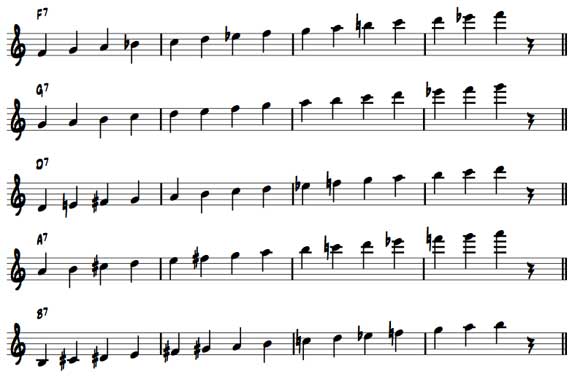
Mastering and understanding these scales in relation to dominant chords can open up a world of melodic possibilities when you improvise over harmonic forms, as well as when you improvise without chord changes. (Note: The above examples are only intended to show the relationship of each minor scale to the natural scale of the dominant chord. The “second octave” concept is one purely of understanding these relationships. You can play the notes in any order that makes musical sense to you when you improvise.)
The third reason I find the melodic minor scale so useful is that I can combine the various scales that relate to any given dominant 7th chord to create interesting, modern sounding melodic colors. By combing C melodic minor and F# melodic minor over a ii-V-I progression in the key of Bb (both scales relate to the F7 chord), I can get a unique melodic shape with lots of tension, contour and release through voice leading:

I have found so many new ways of thinking, imagining and hearing different tonal possibilities by exploring the melodic minor scales.
One of the staples of the more recent modern jazz lexicon is the use of triad pairs. Triads have a very strong tonal implication, and pairing them together can add lots of tension and energy to your improvised lines. I’d like to share with you a very simple way you can organize the C melodic minor scale into a beautiful, stark sounding triad pair pattern that will work nicely over the 5 different V-I chord progressions I’ve mentioned above. Look at the example below, where I form a pattern by combing a D minor triad (formed from the second degree of the scale) and an Eb Augmented triad (formed from the third degree of the scale):

Play this a few times to get it in your ear and under your fingers. Then, by taking various portions of this pattern (exactly as it is), see how you can apply it over V-I progressions:
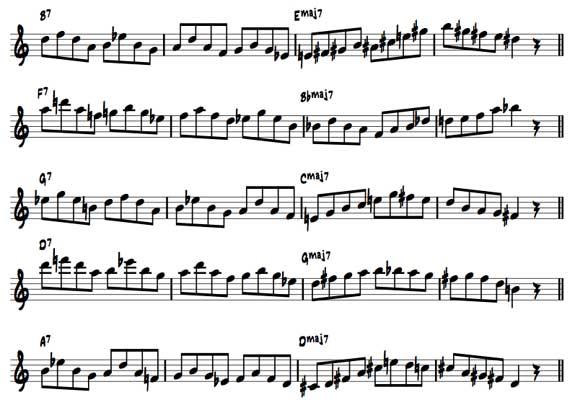
Play through these patterns and notice how each pattern sounds as it resolves differently to each tonic chord. Now, by inverting the pattern a bit and using some rhythmic variations, you get even more possibilities:
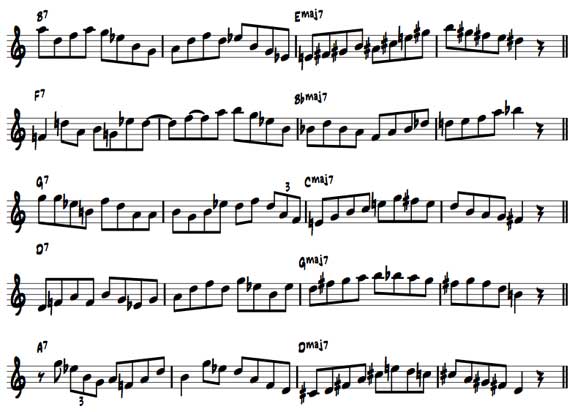
You’ve just covered 5 keys with one triad pair pattern. You don’t have to be a mathematician to realize that if you learned this pattern a half step up (C# Minor), you’d cover 10 keys. Learn it a half step down (B Minor) and you’ll have it in all 12 keys with room to spare. It’s an easy way to add some new movement and interest to your solos.
Here’s a pdf sample for you download from my book, Melodic Minor Scale Jazz Studies, which can serve as a reference. I’ve put this particular triad pair in all keys and demonstrated how each triad pair resolves from the 5 different dominant 7th chords to their corresponding tonics in a variety of ways. Hope you enjoy!
Minor/Augmented Triad Pairs pdf.
Delving Deeper
If you’d like to delve more deeply into melodic minor scales and how they apply to ii-V-I chord progressions, consider my pdf book, Melodic Minor Scale Jazz Studies: Tonal Organizations And Applications Over Dominant 7th Chords. And feel free to contact me through my blog if you have any questions.






April 19, 2015 @ 5:03 pm
very good
December 2, 2015 @ 4:22 pm
Buenisimo
April 21, 2017 @ 4:51 am
looks very interesting (the way you organise the ideas/scale). I’m highly tempted to have a look at your book(s)! Thanks for the article.
November 13, 2019 @ 2:21 pm
Thanks men for the good jazz licks .it open an new musical foor and understanding for me.i learn a lot from this musical improvised information.
Greet
Ray. Jazz pianist